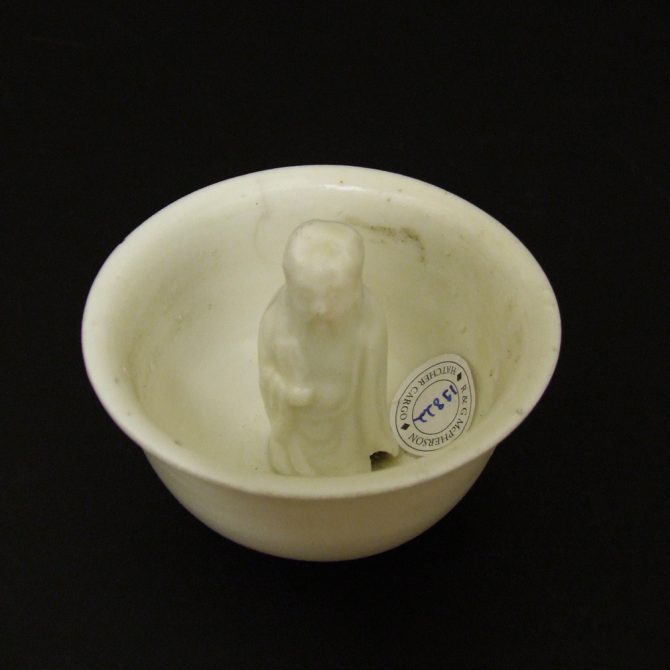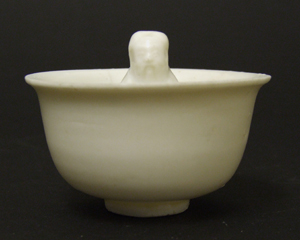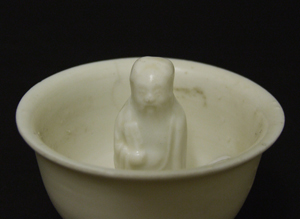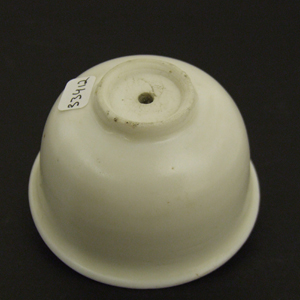
HATCHER CARGO c.1643 Transitional Porcelain
A Blanc de Chine Porcelain `Trick Cup` from the Hatcher Cargo of c.1643. Late Ming or Early Qing Dynasty, Dehua Kilns, Fujian Province. The Figure in the Center is the Immortal Han Zhongli, One of the `The Eight Immortals`, Xian.
SOLD
- Condition
- Some damage, the figure of Xian has a crack to the side, probably due to where it was lutted together. A small rim crack from a firing crack c.9 mm.
- Size
- Diameter : 7.5 cm (3 inches).
- Provenance
- R & G McPherson Antiques, see our `Sold Items` number 19822. A Private English Collection of Blanc de Chine Porcelain. The Hatcher Cargo : The Hatcher Cargo was the first porcelain cargo from a shipwreck to come on to the market. It was sold in several auctions in Christie`s Amsterdam in 1984 and 1985. It remains one of the most important cargoes of shipwreck ceramics ever recovered, despite the lack of historical evidence recorded by the salvage team. Two porcelain covers dated 1643 helped date the wreck but this needed corroborating to give a firm date of the wreck and it`s cargo. The dating of the porcelain from the Hatcher Cargo is based on several elements. Firstly, the ceramics recovered form a coherent group, in other words they appear to all have been made at the same time. Secondly comparative dating was used to corroborate the date of the porcelain. For example, blue and white porcelain dishes decorated with a coiled serpent recovered from the Hatcher Cargo match an important dish from the fall of the Ming dynasty, formerly in the Percival David Foundation, now at the British Museum London, this dish can be dated to 1644 - 1645. Other comparative dating is also consistent with the presumed date of the porcelain. However, the most important dating reference remains the two covers recovered from the wreck datable by inscription to the spring of 1643. Although the the Ming dynasty officially ended in 1644 the transition from the Ming to the beginning of the Qing was messy and protracted. The porcelain made during this period of civil war and chaos is referred to as `Transitional Porcelain`. It covers the period from the last Ming Emperors until the early years of the Kangxi period, which is normally given a date of about 1620 to 1670 . The Hatcher Cargo is a vital dating tool for this previously poorly understood period of Chinese porcelain production.
- Stock number
- 23412
Information
Trick Cups / Gong Dao Bei :
Trick Cups or `Gong Dao Bei` (`don`t be greedy cup` or `fairness cup`) were wine cups where the wine would drain over the lap of heavy drinker. They illustrate the classical Chinese paradigm that modesty brings gain and arrogance results in loss. If you fill the cup to the top, taking more than your share, every drop will drain out onto your lap through a hole in the bottom, but if you are modest and only fill the cup half full you will be able to drink normally. The earliest cups of this type were made during the Song Dynasty (960-1279) but most are 18th or 19th century. For examples in Blanc de Chine as well as celadon with cobalt-blue and copper-red see our `Sold Items`, stock numbers 19828, 18807, 19002, 22109 and 19822. For more information on trick cups and a description of how they work see : Chinese Puzzles, Games for the Hands and Mind, Traditional Chinese Puzzles from the Yi Zhi Tang Collection (Wei Zhang and Peter Rasmussen, Chinese Culture Center of San Francisco, 2008. ISBN 978-1-58886-101-6) pages 76 and 77.
Blanc de Chine Porcelain From Shipwrecks :
By far the largest category of ceramics found on shipwrecks is blue and white porcelain from the kilns at Jingdezhen. Blanc de chine porcelain is sometimes found among the cargo`s recovered but the majority of cargo`s don`t contain this white porcelain from the Dehua kilns in Fujian province. Because blanc de chine porcelain is so difficult to date pieces recovered from shipwrecks are especially important in establishing a credible chronology. Many blanc de chine forms were used over a very long time, indeed even over hundreds of years, pieces recovered from shipwrecks enable subtle changes that occurred to be attributed to precise periods. The 579 objects recovered from the Hatcher wreck of c.1643 represent the most important group of blanc de chine porcelain found so far. 439 of the pieces were bowls, most of which were made as nests of five, but many other forms are represented including archetypal blanc de chine forms such as censers, a guanyin, trick cups as well as standard forms such as vases. Small models of guanyin were also recovered from the Vung Tau Cargo of 1690 as well as acolytes from larger guanyin figures. There were many bowls, dishes, boxes with covers as well as a few water-droppers. There was white porcelain found on the wreck of the Geldermalsen, however this Nanking Cargo porcelain came from the Jingdezhen kilns and so is not blanc de chine.
The Eight Immortals / Xian :
The Eight Immortals are a group of legendary Xian, immortals or transcendents in Chinese mythology. Each Immortals power can be transferred to a power tool that can give life or destroy evil. Together, these eight tools are called `Covert Eight Immortals`. Most of them are said to have been born in the Tang Dynasty or Song Dynasty. They are revered by the Taoists, and are also a popular element in the secular Chinese culture. They are said to live on Penglai Mountain-Island. The Immortals are : Immortal Woman He (He Xiangu),Royal Uncle Cao (Cao Guojiu),Iron-Crutch Li (LiTieguai),Lan Caihe,Lü Dongbin, (leader)Philosopher Han Xiang (Han Xiang Zi),Elder Zhang Guo(Zhang Guo Lao),and Zhongli Quan.


